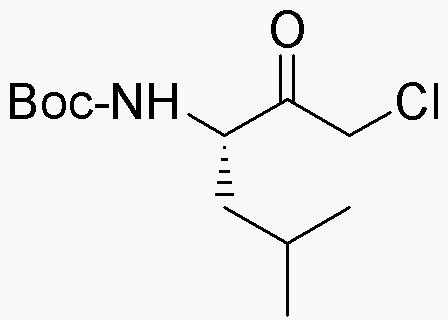Boc-L-leucine chloromethylketone is widely utilized in research focused on:
- Peptide Synthesis: This compound serves as a valuable building block in the synthesis of peptides, particularly in creating modified amino acids that enhance the stability and activity of therapeutic peptides.
- Drug Development: It plays a crucial role in the development of new pharmaceuticals, especially in designing inhibitors for various biological targets, which can lead to more effective treatments.
- Biotechnology: Researchers use it in the production of recombinant proteins, where its unique properties help improve yield and purity during the purification process.
- Material Science: The compound is applied in creating functionalized polymers, which can be used in drug delivery systems, providing controlled release of active ingredients.
- Analytical Chemistry: It is utilized as a reagent in various analytical techniques, helping to identify and quantify compounds in complex mixtures, thus aiding in quality control and research analysis.
General Information
Properties
Safety and Regulations
Applications
Boc-L-leucine chloromethylketone is widely utilized in research focused on:
- Peptide Synthesis: This compound serves as a valuable building block in the synthesis of peptides, particularly in creating modified amino acids that enhance the stability and activity of therapeutic peptides.
- Drug Development: It plays a crucial role in the development of new pharmaceuticals, especially in designing inhibitors for various biological targets, which can lead to more effective treatments.
- Biotechnology: Researchers use it in the production of recombinant proteins, where its unique properties help improve yield and purity during the purification process.
- Material Science: The compound is applied in creating functionalized polymers, which can be used in drug delivery systems, providing controlled release of active ingredients.
- Analytical Chemistry: It is utilized as a reagent in various analytical techniques, helping to identify and quantify compounds in complex mixtures, thus aiding in quality control and research analysis.
Documents
Safety Data Sheets (SDS)
The SDS provides comprehensive safety information on handling, storage, and disposal of the product.
Product Specification (PS)
The PS provides a comprehensive breakdown of the product’s properties, including chemical composition, physical state, purity, and storage requirements. It also details acceptable quality ranges and the product's intended applications.
Certificates of Analysis (COA)
Search for Certificates of Analysis (COA) by entering the products Lot Number. Lot and Batch Numbers can be found on a product’s label following the words ‘Lot’ or ‘Batch’.
Numéro de catalogue
Numéro de lot/série
Certificates Of Origin (COO)
This COO confirms the country where the product was manufactured, and also details the materials and components used in it and whether it is derived from natural, synthetic, or other specific sources. This certificate may be required for customs, trade, and regulatory compliance.
Numéro de catalogue
Numéro de lot/série
Safety Data Sheets (SDS)
The SDS provides comprehensive safety information on handling, storage, and disposal of the product.
DownloadProduct Specification (PS)
The PS provides a comprehensive breakdown of the product’s properties, including chemical composition, physical state, purity, and storage requirements. It also details acceptable quality ranges and the product's intended applications.
DownloadCertificates of Analysis (COA)
Search for Certificates of Analysis (COA) by entering the products Lot Number. Lot and Batch Numbers can be found on a product’s label following the words ‘Lot’ or ‘Batch’.
Numéro de catalogue
Numéro de lot/série
Certificates Of Origin (COO)
This COO confirms the country where the product was manufactured, and also details the materials and components used in it and whether it is derived from natural, synthetic, or other specific sources. This certificate may be required for customs, trade, and regulatory compliance.


